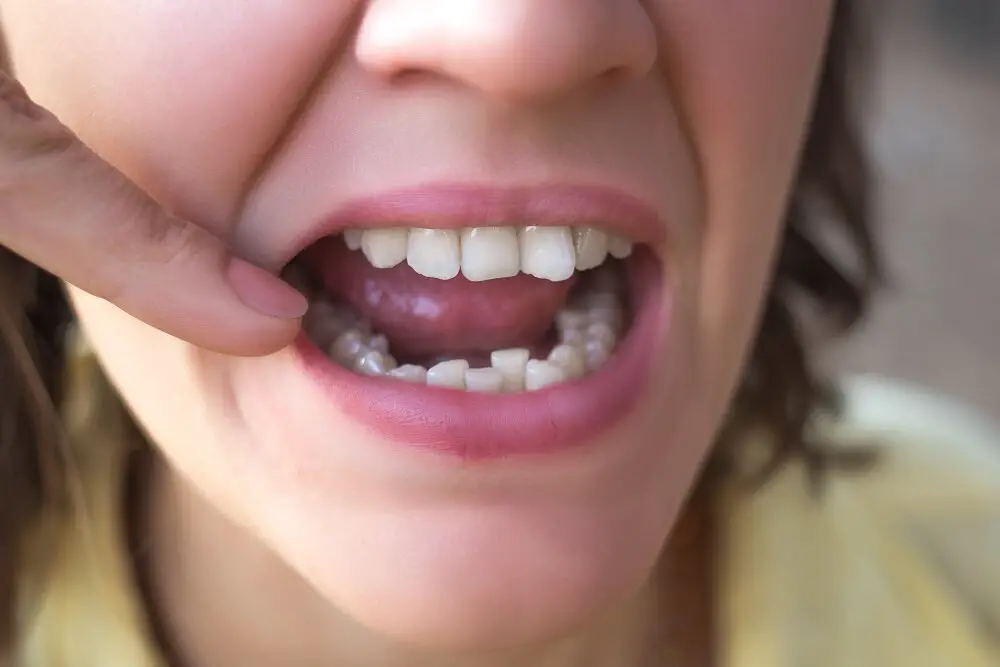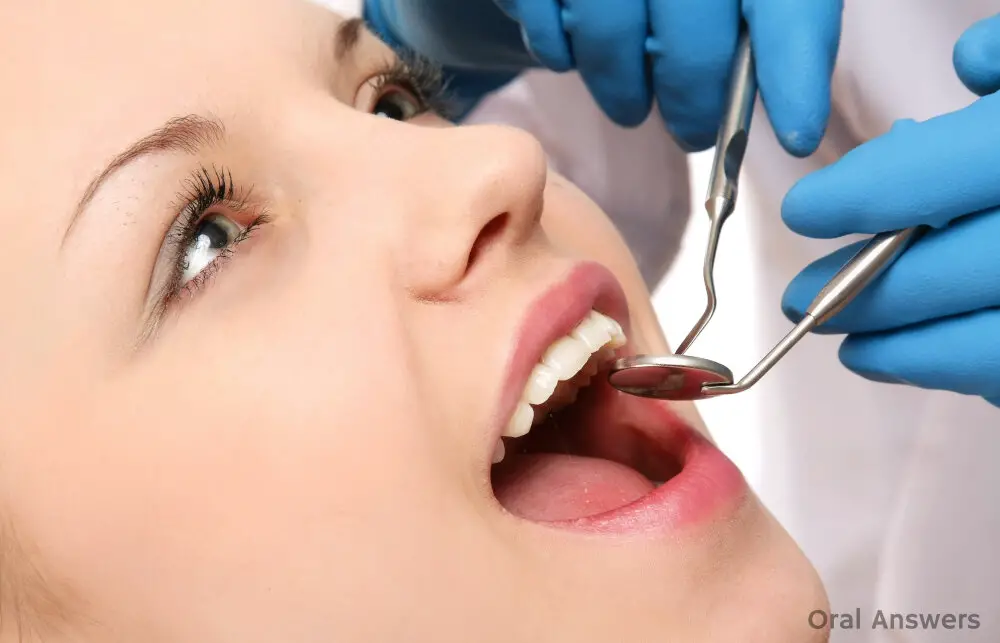Why Do Some Kids Develop Silver Teeth? Understanding the Causes and Treatment Options

Silver teeth or dental amalgam is a common dental practice that has been used for decades. It involves filling a cavity with a mixture of metals, including mercury, silver, tin, and copper. While this procedure is considered safe and effective, some parents are concerned about the cosmetic appearance of the silver fillings in their children’s teeth. Additionally, some children seem to develop more silver teeth than others. This has led to a growing interest in understanding the causes and treatment options for silver teeth in kids. One possible cause of silver teeth in children is genetics. Some children may inherit certain traits that make them more prone to cavities or tooth decay, which can lead to more silver fillings. Additionally, environmental factors such as diet and oral hygiene can also play a role in the development of silver teeth. Understanding the causes of silver teeth can help parents take preventative measures and seek appropriate treatment options for their children. This article will explore the various causes of silver teeth in kids and discuss the available treatment options.
What are Silver Teeth?

Silver teeth, also known as stainless steel crowns, are dental restorations that are commonly used to restore damaged or decayed teeth in children. These crowns are made of a combination of metals, including stainless steel and chrome, and are designed to fit over the entire tooth, providing protection and support. Silver teeth are often used in pediatric dentistry because they are durable, cost-effective, and can be placed in a single visit, making them an ideal option for young patients who may have difficulty sitting still for longer procedures. While silver teeth may not be the most aesthetically pleasing dental restoration, they offer a number of benefits for children’s dental health. They are extremely durable, able to withstand the wear and tear of regular use, and can last for many years. Silver teeth are also very effective at preventing further decay or damage to the tooth, as they completely cover the tooth’s surface and protect it from harmful bacteria. Additionally, because they can be placed in a single visit, they are a convenient option for parents and children who may have busy schedules. Overall, while silver teeth may not be the most attractive option, they are a reliable and effective way to restore damaged or decayed teeth in children.
Causes of Silver Teeth in Kids

Silver teeth in kids are a common phenomenon that can be caused by a variety of factors. One of the most common causes is dental caries or tooth decay. When a child’s tooth begins to decay, the dentist may use silver amalgam to fill the cavity. Silver amalgam is a mixture of silver, mercury, tin, and copper that has been used for over a century to fill cavities. It is durable, long-lasting, and can withstand the constant pressure of chewing. However, silver amalgam can give the tooth a silver appearance, which is why it is commonly referred to as a silver tooth. Another cause of silver teeth in kids is trauma or injury to the tooth. When a child suffers a blow to the mouth, the tooth may become chipped or cracked. In such cases, the dentist may use silver amalgam to repair the damage. This can result in a silver tooth that is noticeable when the child smiles or speaks. While silver teeth may be unsightly, they are not harmful to a child’s health. In fact, silver amalgam is considered safe by the American Dental Association and has been used for many years without any adverse effects. However, if a child is self-conscious about their silver tooth, there are treatment options available to restore the tooth’s natural appearance.
Genetics play a significant role in the development of silver teeth in children. Genetic variations can lead to mineralization disorders, causing tooth discoloration, and lead to silver or gray-colored teeth. These mineralization disorders can occur due to mutations in specific genes that regulate the formation and distribution of minerals in teeth. Additionally, genetic factors may also influence the structure of the enamel, causing it to be more susceptible to staining. Identifying these genetic factors can help in understanding the underlying causes of silver teeth and developing effective treatment options tailored to the individual needs of the patient.
Poor oral hygiene can lead to a range of dental problems, including the development of silver teeth. When children do not brush and floss their teeth regularly, bacteria can build up in their mouths, causing tooth decay and cavities. If left untreated, these cavities can progress to the point where the tooth enamel is completely eroded, exposing the dentin layer of the tooth. This can cause the tooth to turn silver or gray in color and become more susceptible to further decay and infection. To prevent silver teeth from developing, it is important for children to practice good oral hygiene habits, such as brushing twice a day, flossing daily, and visiting the dentist regularly for checkups and cleanings.
Overexposure to fluoride is one of the potential causes of silver teeth in children. Fluorosis, a condition caused by the intake of excessive amounts of fluoride, can result in the development of silver or brown stains on teeth. Fluoride is a mineral that is beneficial for dental health in small amounts, but excessive exposure can lead to fluorosis. This can occur from drinking water with high levels of fluoride, using too much fluoride toothpaste, or taking fluoride supplements. While fluorosis does not typically cause any health problems, it can be a cosmetic concern, and treatment options such as teeth whitening or dental bonding may be considered to improve the appearance of affected teeth.
Childhood trauma refers to a painful or distressing event or experience that a child goes through, which can have long-lasting effects on their physical, emotional, and mental health. These traumatic experiences can include physical, sexual, or emotional abuse, neglect, violence, accidents, natural disasters, or witnessing or being exposed to traumatic events. Childhood trauma can lead to a range of psychological and behavioral problems, such as anxiety, depression, post-traumatic stress disorder (PTSD), substance abuse, self-harm, and suicidal thoughts. It is crucial that children who have experienced trauma receive appropriate support and treatment to help them overcome the effects of their experiences and lead healthy and fulfilling lives.
Treatment Options for Silver Teeth

Silver teeth, also known as silver tooth syndrome or dental fluorosis, can be a cause of concern for some parents. This condition occurs when children are exposed to excessive amounts of fluoride during the development of their teeth. While the condition is not harmful to a child’s health, it can cause cosmetic concerns as the child’s teeth may appear discolored or mottled. Fortunately, there are several treatment options available for silver teeth. One treatment option for silver teeth is dental bonding. This procedure involves applying a tooth-colored composite resin to the surface of the affected teeth. The resin is then shaped and polished to create a natural-looking tooth surface that blends in with the surrounding teeth. Dental bonding is a quick and painless procedure that can be completed in a single visit to the dentist’s office. It is also an affordable option for parents who are concerned about the cost of more extensive treatments. Another treatment option for silver teeth is dental veneers. Veneers are thin, custom-made shells that are applied to the front of the teeth to improve their appearance. They are made from porcelain or composite resin and can be colored to match the surrounding teeth. Veneers are a more permanent solution than dental bonding, as they typically last for several years. However, they are also more expensive and require more preparation before they can be applied.
Composite resin fillings are a popular alternative to traditional silver fillings for children who need dental work. This material is made up of a mixture of plastic and glass and is available in a variety of shades that can match the natural color of a child’s teeth. Composite resin fillings are also less invasive than silver fillings, as less of the tooth needs to be drilled away to accommodate the filling. Additionally, composite resin fillings are more durable and can last longer than silver fillings. Overall, composite resin fillings are a safe and effective option for children who require dental work.
Ceramic crowns are one of the most popular and aesthetically pleasing teeth restoration options for children who develop silver teeth due to cavities, decay, or trauma. These crowns are made of high-quality ceramic materials and are custom-made to fit the child’s teeth perfectly. They are bonded to the child’s natural teeth using a special dental adhesive, providing a durable and long-lasting solution. Ceramic crowns are also highly resistant to wear and tear, making them an ideal choice for active children who engage in sports and other physical activities. With proper care and maintenance, ceramic crowns can last for many years, providing children with a beautiful and healthy smile that they can be proud of.
Stainless steel crowns are commonly used as a dental restoration for children’s primary teeth that have been severely damaged or decayed. These crowns are made of a durable, corrosion-resistant alloy that is designed to withstand the wear and tear of a child’s active lifestyle. Stainless steel crowns are pre-fabricated to fit the specific shape and size of a child’s tooth, and they can be easily placed and removed by a dentist. While they may not be the most aesthetically pleasing option, stainless steel crowns are an effective and cost-efficient method for treating dental decay in young children. In addition, they can help to prevent further damage to the tooth and promote healthy oral hygiene habits that can last a lifetime.
Extraction is a dental procedure wherein a tooth is removed from its socket in the jaw bone. This treatment option is usually considered when the tooth in question has been severely damaged and cannot be saved through other means such as fillings, crowns, or root canals. In the case of children, extraction may be necessary if their primary teeth are not falling out on their own, or if there is crowding in the mouth that could affect the growth and alignment of permanent teeth. While extraction can be a daunting prospect, modern dental techniques and anesthesia make the process relatively painless and ensure a faster recovery time. Your dentist can advise you on whether extraction is the best option for your child’s dental health.
Prevention of Silver Teeth in Kids

Preventing silver teeth in kids is an essential aspect of maintaining their dental health. One of the most effective ways to prevent this condition is by practicing proper oral hygiene. Parents should ensure that their children brush their teeth at least twice a day, with fluoride toothpaste. It’s also important to floss daily and maintain a healthy diet, avoiding sugary foods and drinks that can cause tooth decay. Regular dental checkups are crucial to detect any potential dental issues early on and prevent them from developing into more severe conditions. Another crucial prevention measure is the application of dental sealants. These are plastic coatings that are applied to the chewing surfaces of the back teeth, where tooth decay is most likely to occur. Dental sealants create a barrier that prevents bacteria and food particles from getting trapped in the crevices of the teeth, reducing the risk of decay. Fluoride treatments can also be applied to strengthen the teeth and prevent decay. By taking these preventive measures, parents can help their children maintain healthy teeth and avoid the need for silver fillings.
Regular dental checkups are an essential aspect of maintaining good oral hygiene for both children and adults. These checkups help to identify any potential dental issues before they become more severe and require complex and expensive treatments. During a dental checkup, a dentist examines the teeth, gums, and mouth for signs of decay, gum disease, or other dental problems. Additionally, regular dental checkups can help to prevent the development of silver teeth, which is a condition that occurs when cavities are left untreated for an extended period. As such, it is recommended that children visit the dentist at least twice a year to ensure that their teeth and gums remain healthy and free from decay.
Maintaining good oral hygiene is crucial for preventing dental issues, including silver teeth. Brushing twice a day with fluoride toothpaste, flossing daily, and visiting the dentist regularly are essential for maintaining healthy teeth and gums. Parents should supervise their children when brushing and flossing to ensure they are doing so correctly. Additionally, limiting sugary and acidic foods and drinks can help prevent tooth decay and erosion. By establishing good oral hygiene habits early on, children can avoid developing silver teeth and other dental problems in the future.
A balanced diet is crucial for overall health and oral health, including the prevention of silver teeth. A balanced diet includes a variety of fruits and vegetables, whole grains, lean proteins, and low-fat dairy products. Consuming excess sugar and carbohydrates can cause tooth decay, leading to the need for treatments like silver teeth. A balanced diet can also help maintain a healthy weight, reducing the risk of other health issues. It is important to encourage children to make healthy food choices and limit sugary snacks and beverages to promote good oral health and overall well-being.
Overexposure to fluoride can lead to various dental problems, including the development of silver teeth. Fluoride is a mineral that is commonly found in tap water, toothpaste, and other dental products. While fluoride can help prevent tooth decay, excessive exposure to it can cause a condition called fluorosis, which can lead to the discoloration and pitting of teeth. To avoid overexposure to fluoride, it is recommended to use fluoride-free toothpaste for young children, limit the amount of toothpaste used during brushing, and provide children with bottled water instead of tap water if the fluoride levels in your area are high. It is also important to supervise young children while they brush their teeth to ensure they do not swallow toothpaste.
Conclusion

In conclusion, silver teeth in kids can be a result of several factors such as genetics, poor dental hygiene, or excessive intake of sugary foods and drinks. It is essential to address the underlying cause and seek prompt dental treatment to prevent further complications. Treatment options may include fillings, crowns, or extraction, depending on the severity of the condition. Proper oral hygiene practices such as regular brushing, flossing, and dental checkups can help prevent the development of silver teeth in kids. Overall, early intervention and preventive measures are crucial in maintaining good dental health and ensuring a bright, healthy smile for your child.






